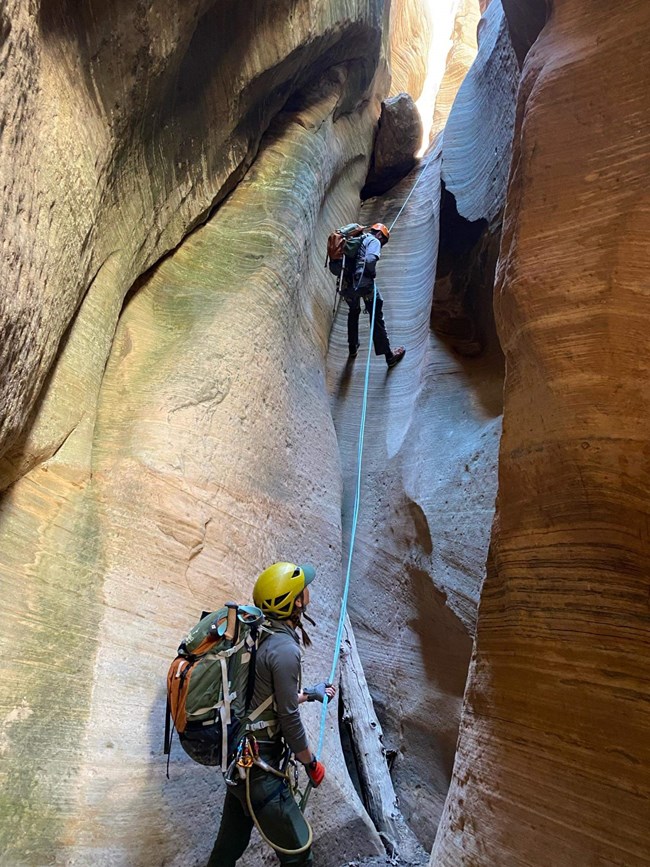
NPS Image Watch the Canyoneering Safety Video Be PreparedTraveling into the wilderness, even on short trips, can be challenging and risky and requires careful planning before you begin. Your safety depends on your own good judgment, adequate preparation, and constant observation. Speak with park rangers at park visitor centers for current conditions, weather forecasts, and flash flood potential ratings. Flash FloodsFlash floods, often caused by storms miles away, are a real danger and can be life threatening. Know the weather and flash flood potential forecasts before starting your trip. If bad weather threatens, do not enter a narrow canyon. Flash floods can occur during periods when they are not expected. When the National Weather Service states that there is a 30 percent chance of rain, they are not stating that there is a 30 percent chance that it will rain. They are stating that 30 percent of the forecast area will be affected by measurable precipitation. Continuously evaluate weather conditions. If bad weather threatens, avoid traveling in a slot canyon. Watch for these indications of a possible flash flood: If you observe any of these signs, seek higher ground immediately. Even climbing a few feet may save your life. Remain on high ground until conditions improve. Water levels usually drop within 24 hours. Despite the forecast, flooding is possible at any time, and floods have occurred on days they were not expected. A possible or probable flash flood potential should be a serious cause for concern. What To BringMap and Route DescriptionYou must have and use them. Carefully assess your location before beginning your first rappel. Even heavily traveled canyons in the park are routes, not maintained trails. Do you have a map and a route description? Are you confident in your ability to use them? When you enter a canyon and pull your rope after your first rappel, you are committed. You must complete the canyon whether or not it is the canyon that you intended to enter. Flashlight / HeadlampEvery week, canyoneers spend unintended nights camped in the wilderness of the park. A headlamp could make the difference between spending the night in the canyon and making it out. First Aid KitEven a minor injury can cause major problems in the wilderness. Extra ClothingCould you spend an unexpected night in the canyon? Extra FoodFood keeps your energy up and helps you stay warm if you remain out overnight. Ropes, Harnesses, and Rappelling EquipmentKnow how much rope you will need to complete the canyon safely, and consider bringing extra. Ropes frequently get stuck when being pulled after rappels. A minimum group size of 2 people is recommended for all technical canyons involving the use of rope, webbing, or other device for descent or ascent. Anchor EquipmentCan you replace webbing if it is worn? Can you create a new anchor if needed? Backup EquipmentThe ability to stop, move up, or down while hanging mid-rope is a lifesaving skill that must be learned before you need it. Can you create extra friction? Do you have ascenders? Can you belay the less experienced members of your group? HelmetRock falls can cause severe injuries. Know How To Self-RescueCan you assist another group member? Are you capable of stopping yourself mid-rappel to correct a problem? If not, consider taking a canyoneering course before heading out on your own. Do Not JumpLower leg fractures are the most common injuries suffered in the wilderness. The most common cause of lower leg injuries is jumping. Do not jump. Bring a rope and use it. Steep CliffsFalls from cliffs on trails have resulted in deaths. Loose sand or pebbles on stone are very slippery. Be careful of edges when using cameras or binoculars. Never throw or roll rocks, as there may be hikers below you. Trails can be snow and ice covered in winter. WaterThe desert is an extreme environment. Carry enough water, one gallon per person per day, and drink it. Water is available at visitor centers, campgrounds, and the Zion Lodge. Water flow at natural springs can vary, check for information at visitor centers. Do not drink untreated water. Water collected in the wilderness is not safe to drink without treatment. There are two safe methods to treat water.
HypothermiaHypothermia occurs when the body is cooled to dangerous levels. It is the number one killer of outdoor recreationists, even in summer, and it usually happens without the victim's awareness. It is a hazard in narrow canyons because immersion in water is the quickest route to body heat loss. To prevent hypothermia, avoid cotton clothing (it provides no insulation when wet) and eat high-energy food before you are chilled. Wetsuits or even Drysuits are necessary in many Zion canyons in even the hottest temperatures. • Uncontrollable shivering Heat ExhaustionHeat exhaustion occurs when the body loses more fluid than is taken in. Signs of heat exhaustion include nausea, vomiting, fatigue, headaches, pale appearance, stomach cramps, and cool clammy skin. If a member of your party begins to experience any of these symptoms, stop your hike immediately. Find a cool, shady area and rest with your feet up to distribute fluids throughout your body. It is important to drink fluids, but it is also important to eat. Drinking lots of fluids and not eating, while suffering from heat exhaustion, can lead to a potentially dangerous condition of low blood salt. If heat exhaustion symptoms persist for more than two hours, seek medical help. Heat stroke is an advanced stage of heat exhaustion. It is the body's inability to cool itself. Symptoms include confusion, disorientation, behavior changes, and seizures. If you believe that a member of your party is suffering from heat stroke, it is imperative to cool them using any available means and obtain immediate medical assistance. |
Last updated: October 23, 2021
